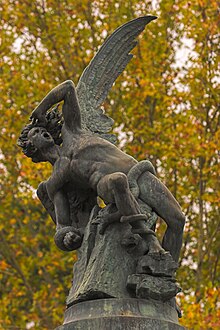
Back ملاك ساقط Arabic Düşmüş mələklər AZ Паднал ангел Bulgarian Àngel caigut Catalan Padlý anděl Czech Falden engel Danish Höllensturz German Falintaj anĝeloj EO Ángel caído Spanish Langenud ingel ET

Fallen angels are angels who were expelled from Heaven. The literal term "fallen angel" does not appear in any Abrahamic religious texts, but is used to describe angels cast out of heaven[1] or angels who sinned. Such angels often tempt humans to sin.
The first idea of the concept of fallen angels may be found in Canaanite beliefs about the bənē hāʾĔlōhīm ("sons of God"), expelled from the divine court. Hêlêl ben Šāḥar is thrown down from heaven for claiming equality with ʻElyōn. Such stories are later collected in the Old Testament and appear in pseudepigraphic Jewish literature. Under the assumption that the "sons of God" (בני האלוהים) mentioned in Genesis 6:1–4 or the Book of Enoch, derives the concept of fallen angels. In the period immediately preceding the composition of the New Testament, some groups of Second Temple Judaism identified these "sons of God" as fallen angels. During the late Second Temple period the Nephilim were considered the monstrous offspring of fallen angels and human women. In such accounts, God sends the Great Deluge to purge the world of these creatures; their bodies are destroyed, yet their peculiar souls survive, thereafter roaming the earth as demons. Rabbinic Judaism and early Christian authorities after the third century rejected the Enochian writings and the notion of an illicit union between angels and women producing hybrids.
Christian theology indicates the sins of fallen angels occur before the beginning of human history. Accordingly, fallen angels became identified with those led by Lucifer in rebellion against God, also equated with demons. Conceptualizing fallen angels as spirits, Western Christianity integrated fallen angels into theological questions.
The Quran refers to motifs reminiscent of fallen angels in earlier Abrahamic writings. However, the interpretation of these beings is disputed. Some Muslim exegetes regard Satan (Iblīs) to be an angel, while others do not.[2] According to the viewpoint of Ibn Abbas (619–687), Iblis was an angel created from fire (nār as-samūm), while according to Hasan of Basra (642–728), he was the progenitor of the jinn.[3][4] Harut and Marut are a pair of angels mentioned in the Quran who are often said to have fallen to earth due to their negative remarks on humanity.
- ^ Crone, Patricia (2016). Azaiez, Mehdi; Reynolds, Gabriel Said; Tesei, Tommaso; Zafer, Hamza M. (eds.). The Qur'an Seminar Commentary / Le Qur'an Seminar: A Collaborative Study of 50 Qur'anic Passages / Commentaire collaboratif de 50 passages coraniques (in French and English) (bilingual ed.). De Gruyter. pp. 387–390. ISBN 9783110444797.
- ^ Erdağı, Deniz Özkan (1 February 2024). "Evil in Turkish Muslim horror film: the demonic in "Semum"". SN Social Sciences. 4 (2): 1–22. doi:10.1007/s43545-024-00832-w. ISSN 2662-9283.
- ^ Akbari, Mahtab, and Reza Ashrafzadeh. "A comparative study of the image of the devil in the logic of Attar Attar and the commentary of Abolfotuh Razi." Propósitos y representaciones 9.2 (2021): 100.
- ^ Öztürk, Mustafa. "The Tragic Story of Iblis (Satan) in the Qur’an." Journal of Islamic Research 2.2 (2009): 128-144.